OVERVIEW
This 13-day trip will give you the opportunity to understand more on the customs, culture as well as the daily life activities of Cambodian people..
TRIP HIGHLIGHTS
Phnom Penh, Kampong Cham, Kratie (Dolphin), Kampnog Thom, Siem Reap (Angkor Wat), Battambang, Kep, Sihanoukville
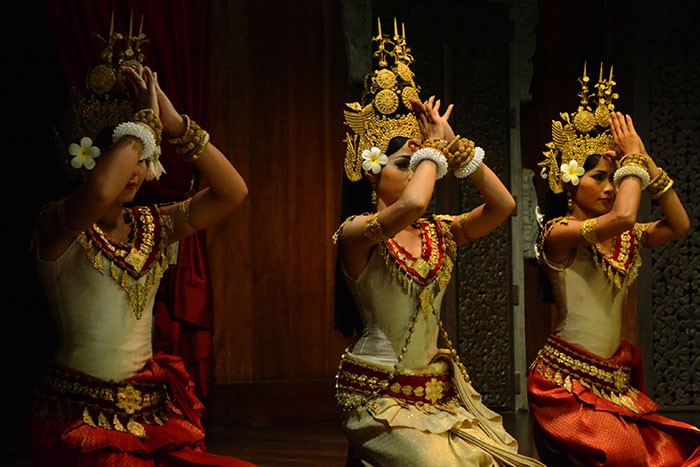
ITINERARY
Cambodia Discovery & Adventure
- Afternoon visits
Arrive in the morning – meet with guide for transfer to hotel (check in from 2PM)
Lunch on arrival.
Phnom Penh is the vibrant bustling capital and the largest city of Cambodia, situated at the confluence of three rivers: the mighty Mekong, the Bassac and the great Tonle Sap. Phnom Penh has been the national capital since French colonization of Cambodia and has grown to become the nation's centre of economic and industrial activities, as well as the center of security, politics, cultural heritage and diplomacy of Cambodia.
Once known as the "Pearl of Asia", it was considered one of the loveliest French-built cities in Indochina in the 1920s.
The capital city still maintains considerable charm with plenty to see, reflecting a sort of provincial charm and tranquillity with French colonial mansions and tree-lined boulevards amidst monumental Angkorian architecture. Phnom Penh is a veritable oasis compared to the modernity of other Asian capitals.
Tour orientation and visits:
- the Independence Monument which is built in 1958 to memorialize Cambodia's independence from France in 1953 stands on the intersection of Norodom Boulevard and Sihanouk Boulevard in the centre of the city. It is in the form of a lotus- shaped stupa, of the style seen at Khmer temples and historical sites. The Independence Monument was designed by the Cambodian architect Vann Molyvann
- the Cambodia – Vietnam Friendship Monument, a large concrete monument commemorating the former alliance between VIetnam and Cambodia, built in the late 1970s by the communist regime that took power after the Cambodian-Vietnamese war, which overthrew the Khmer Rouge regime. The monument is located at the Botum Park near the centre of Phnom Penh, featuring heroic statues of Vietnamese and Cambodian soldiers in the “Socialist realist” style developed in the Soviet Union in the 1930s, together with images of a woman and baby representing Cambodian civilians. The monument is in a popular park in the middle of the city.
Transfer back to hotel.
Overnight in Phnom Penh.
- All day visit the capital city of Phnom Penh
Breakfast at hotel.
Proceed to visit Phnom Penh capital city:
- Wat Phnom Pagoda translated as "hill temple" - is the tallest and most important temple in the Cambodian capital of Phnom Penh. The temple, first constructed in 1373, was erected on a man - made, 27-metre-tall mound overlooking the city. It is the tallest religious structure in the city. Legend relates that Daun Penh, a wealthy widow, found a large koki tree in the river. Inside the tree she found four bronze statues of the Buddha. Lady Penh constructed a small shrine on an artificial hill made by the people living in the village to protect the sacred statues. Eventually this became a sacred site and sanctuary where people would make blessings and pray.
- Silver Pagoda, also called Emerald Pagoda: is located inside the Royal Palace complex. It is called Silver Pagoda as there are 5,329 tiles of silver inlaid on the floor, each tile of silver is handmade and weighs 1,125 grams. The pagoda has a cultural function and keeps precious religious objects more than a place of worship. There are over 1650 valuable objects in the pagoda. The statue of Buddha sit atop throne in the main temple is in emerald.
- Royal Palace:The Royal Palace of Cambodia is a complex of buildings being built over one century ago to be the royal abode to the King of Cambodia, the royal family and the foreign guests. It is also the place where take place the king’s audience, coronations and official ceremonies. The buildings with beautiful towering spires are a great example of classic Khmer architecture found in Cambodia today.
Along with numerous other interesting buildings within the 183,135 square meters (421m x 435m) compound is the Khemarin Palace, also known as Prasat Khemarin or the "Palace of the Khmer King." This is officially the residence of His Majesty, King Norodom Sihamoni.
The visit to the Royal Palace includes the Throne Hall, the Temple of the Emerald Buddha, Stupas, a Royal Dining Hall, the Chan Chhaya Pavilion and a French-style building that was a gift from Napoleon III French King.
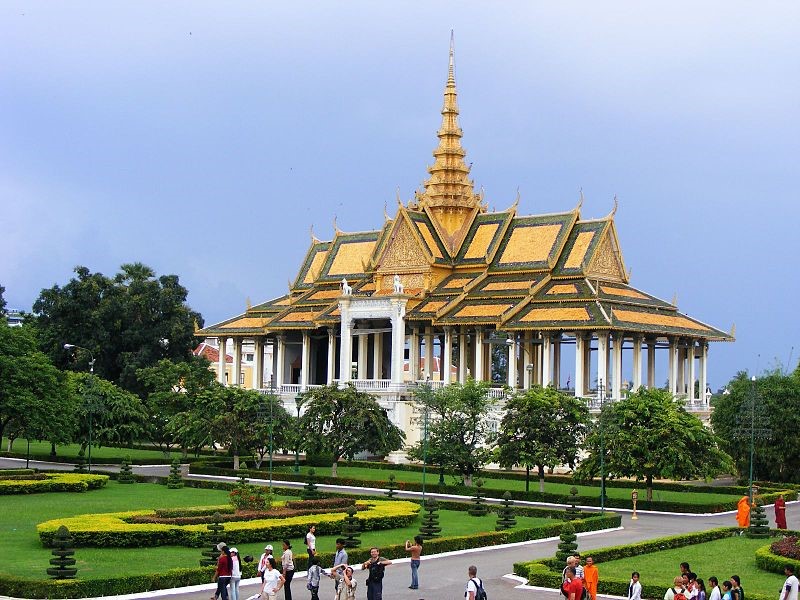
- National Museum, located at the North of the Royal Palace, is the largest museum of cultural history and is the country's leading historical and archaeological museum.
The museum houses one of the world's largest collections of Khmer art, including sculptural, ceramics, bronzes, and ethnographic objects. The Museum’s collection includes over 14,000 items, from prehistoric times to periods before, during, and after the Khmer Empire, which at its height stretched from Thailand across present-day Cambodia, to southern Vietnam. The Museum buildings, inspired by Khmer temple architecture, were constructed between 1917 and 1924, the museum was officially inaugurated in 1920, and it was renovated in 1968.
- Riverfront Park: The Riverfront Park is located by the concourse of the Tonle Sap, the Bassac and the Mekong and is a remnant of the city’s glamorous past. The park is known for its scenic views and is a terrific place to just relax or take a stroll. The best time to visit is either early in the morning or in the evening; it can get pretty warm in the afternoon. Travellers who are not averse to waking up early should definitely try to catch the sunrise from Riverfront Park. It will undoubtedly be a sight to remember.
- Toul Sleng Genocide Museum which was a former secondary school, was used as the S-21 interrogation and detention center of the Khmer Rouge regime from its rise to power in 1975 to its fall in 1979. Located in the heart of Phnom Penh, it preserves a tragic period in history with the aim to encourage visitors to be messengers of peace.
- Cheung Ek Killing field is the site of a former orchard and mass grave of victims of the Khmer Rouge - killed between 1975 and 1979 – at about 17 kilometres south of the Phnom Penh city centre. It is the best-known of the sites known as Killing Fields, where the Khmer Rouge regime executed over one million people between 1975 and 1979.
Free time for shopping at New Central Market.
Overnight in Phnom Penh.
- Road transfer 35kms, 1hr – Afternoon visit
Breakfast at your hotel.
Excursion to Oudong, an ancient town of the post-Angkorian period (1618-1863), former capital of Cambodia, situated in present-day Phsar Daek Commune, Ponhea Lueu District, Kandal province.
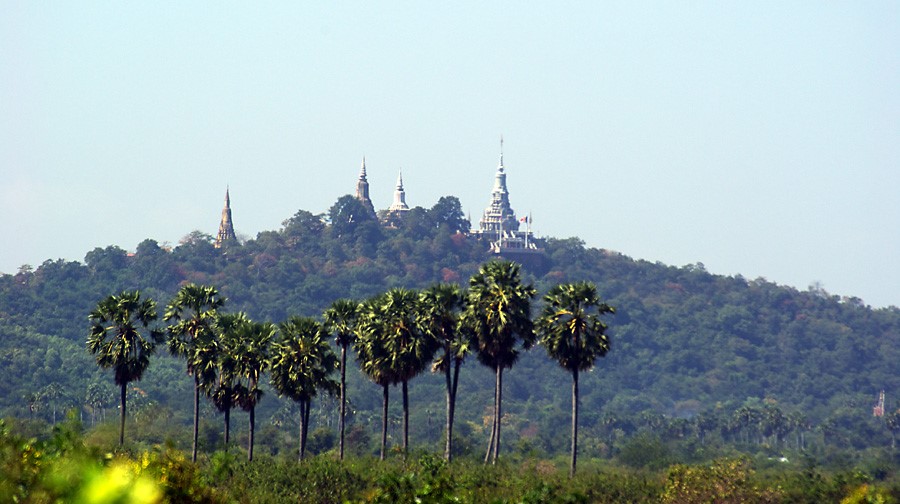
Located at the foothill of the mountain Phnom Oudong, also known as Phnom Preah Reach Troap about 35 km northwest of the modern capital Phnom Penh, via National Road No. 5, Oudong was royal residence and Cambodia's capital for more than 250 years until 1866. A monumental royal necropolis of sovereigns of several centuries is scattered on top the prominent bisected mountain, which runs from the southeast to the northeast.
On the way, short stop at Phnom Prasith.
Phnom Prasith is composed of two hills, the East Hill and the West Hill. The West Hill has no stories. The East Hill, however, has stories relating to religion and the Khmer king. It also has a large statue of the reclining Buddha reaching nirvana. From the hilltop temple, you can enjoy fresh air, beautiful view of surrounding plains and rice fields.
Continue to Ou Dong, lunch on arrival.
Afternoon visit: The main site perched on top of the mountain consists of one large new temple, three main stupas, and several smaller temples.
- Stupas where the ashes of three former kings are preserved: Damrei Sam Poanstupa was built by King Chey Chetha II (1618–26). The ashes of his predecessor King Soriyopor, the founder Oudong, are there. The Ang Doung stupa, in the middle, was named after the father of King Norodom. Built in 1891 by King Norodom it houses King Ang Duong’s (1845–59) ashes. The last stupa is Mak Proum, the funeral stupa of King Monivong (1927–41). It is the one that contains four faces looking into four directions.
- the Vihara of 18 Cubit Buddha temple
Transfer back to Phnom Penh.
Overnight in Phnom Penh.
- Road transfer 184kms, 3hrs45mn
Breakfast at your hotel.
Departure to Kampong Thom, is Cambodia's second largest province by area. There are a number of significant Angkorian sites in the area. As one of the nine provinces bordering Tonle Sap Lake, Kampong Thom is part of the Tonle Sap Biosphere Reserve.
On the way, short stop at Skun district of Kampong Cham, the third largest city in Cambodia and the capital of the province with the same name to see the spiders sold to eat.
Visits:
- Phnom Pros and Phnom Srey: Two hills face one another in a near stand-off, each topped with their own pagodas: The rather lovely, grand and ornate pagodas on top of Phnom Pros (Men’s Hill), and a rather shabbier cluster on top of Phnom Srei (Women’s Hill). At the top of 308 steps, Phnom Srey offers splendid views over the countryside with Kompong Cham and the Mekong easily visible, while further in the distance the rising plateau of Mondulkiri can be seen. Phnom Pros is far smaller than Phnom Sray but the trio of tall temples abutting each other have been built at the summit in an attempt to compensate for the hill’s small size.
- Wat Nkor Bachay: Wat Nokor Bachay is a a relatively modern pagoda buried within the walls of an Angkorian temple dating back to the era of Jayavarman VII. This was the warrior king who also built Bayon, Ta Prohm, Preah Khan, Banteay Chhmar, and many, many more. Just over a kilometre out of town, on the road towards Phnom Penh, the original sandstone and laterite temple is made up of a central tower decorated with motifs and Buddhist scenes characteristic of Bayon and is surrounded by four laterite enclosures.
· Wat Kohear Nokor of Phum Prasat: Kohear Nokor also called Wat Nokor is a pre-Angkorian temple dating from the 11th century. This temple is part of the complex called Banteay Prei Nokor in Kampong Thom Province, located 1,200 meters northwest of Kompong Cham town. The construction of this Buddhist monument would have started in the 10th century under Jayavarman, then would have been interrupted. The temple would then have been adapted to Brahmanic worship. It is a magnificent place which charms locals and tourists alike for its beauty and peaceful and spiritual atmosphere. The site is buried in nature, in the heart of the vegetation, which makes it very pleasant to visit. The building has an older part and a more modern one, it mixes original elements with several materials, sandstone and laterite. It is especially renowned and appreciated for its charming, typical ornaments and Buddhist style decorations. Transfer to hotel for check in. Overnight at Kampong Thom.
- Road transfer 187kms, 3hrs20mn
Lunch upon arrival Siem Reap – Check in at hotel.
PM visits: Small Circuit
Prasat Kravan ( Cardamon sanctuary), Banteay Kdei (one of the most mysterious temples of the Angkor complex. It is said that Banteay Kdei is a Buddhist monastery with hundreds of Buddha statues excavated from this site. The temple was probably built in the 12th century, around the same time as Ta Prohm temple), Shrah Sang (Lake Srah Srang is an artificial lake created by the ancient king. The lake has a fairly simple part of architecture, including steps to the lake. In the past, kings used to take boats to the middle of the lake for sightseeing, especially watching the sunrise on the lake, being a pleasure and relaxation) Ta Prohm (Jungle Temple) Takeo (the temple of Shiva, built during the reign of King Jayavarman V), Thommanon, Chau say Tevoda neatly frame the east causeway to the Angkor Thom complex.
Overnight in Siem Reap
- South Gate of Angkor Thom and Angkor Wat
Breakfast at your hotel.
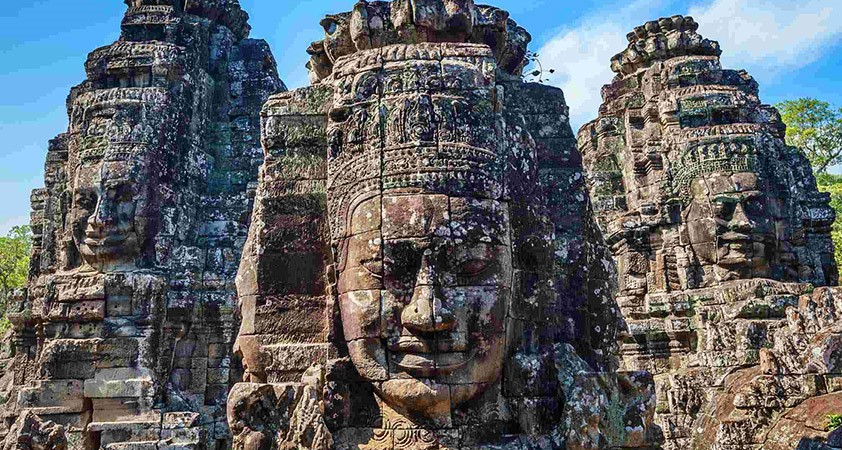
Angkor Thom is a wonder of the world to discover its beauty. The temple is quite beautiful and majestic. It still keeps almost the structure of the work that is well preserved. Angkor Thom is also known as the Temple of Trees because there are many types of trees in this area. Along the way you can enjoy the local people's music program with the traditional instruments of this country, which is a remarkable activity
Proceed to morning visits with South Gate of Angkor Thom for including the famous Bayon Temple (featuring a sea of over 200 massive stone faces looking in all direction, built in the 12th century by King Jayavarman VII as part of a massive expansion of his capital Angkor Thom, built at the exact center of the royal city), Phimeanakas Temple within the Royal Palace enclosure, Baphuon Temple, the Terrace of the Elephants and the Terrace of the Leper King.
Lunch in a local restaurant.
The afternoon is dedicated to visit the most famous & magnificent Angkor Wat temple.

This architectural masterpiece was constructed in the 12th century and covers an area of about 210 hectares. With many galleries with columns, libraries, pavilions, courtyards and ponds full of water, carved low reliefs about Ramayana Story and day-to-day life at the time of Angkor's construction.
At the end of the afternoon Angkor Wat discovery watches the sunset on the temples and the spectacular views over Angkor Wat from Phnom Bakheng Hill.
Overnight at hotel in Siem Reap.
- Boat cruise transfer to Battambang
Breakfast at hotel.
Transfer to the port to embark for a cruise trip to cross Tonle Sap then along the Sang Kae River to reach Battambang, passing several floating villages, protected wetlands. During the cruise, you will have the opportunity to have a glimpse of the fantastic wilderness as well as witness the daily life of the locals on water.
Battambang or Krong Battambang (Battambang City) is the capital city of Battambang province in northwestern Cambodia.
Founded in the 11th century by the Khmer Empire Battambang is the leading rice-producing province of the country. For nearly 100 years it was a major commercial hub and provincial capital of Siamese province of Inner Cambodia (1795-1907), though it was always populated by Khmer, with some ethnic Vietnamese, Lao, Thai and Chinese. Battambang remains the hub of Cambodia's northwest, connecting the region with Phnom Penh and Thailand.
The city is situated on the Sangkae River, a tranquil, small body of water that winds its way picturesquely through Battambang province. As with much of Cambodia, French Colonial architecture is a notable aspect of the city, with some of the best-preserved examples in the country. Now the government and Ministry of Culture and Fine Art are preparing documents to nominate The Old Town of Battambang in the list of UNESCO world heritage site along with The Old Town of Kampot and The Old Town of Kratie since 2017.
On arrival at the pier at Battambang, transfer to lunch in a local restaurant, then to Wat Banan Temple for a visit.
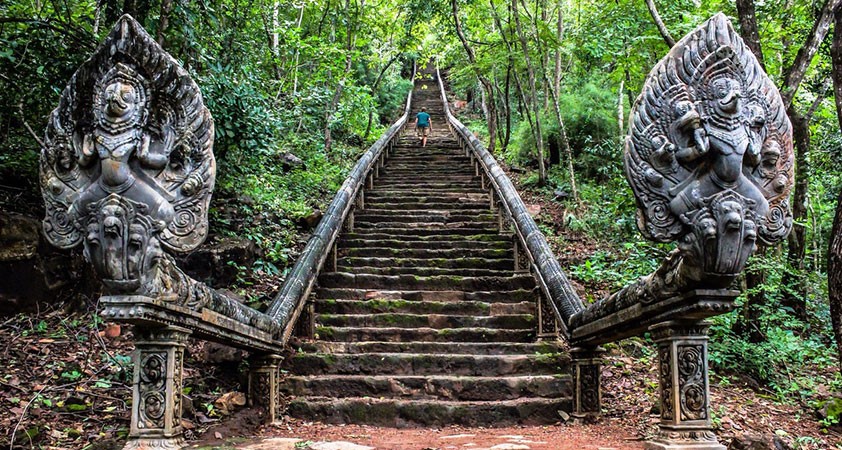
The temple is at Kon Tey 2 commune, Ba Nan district in 25km far from the centre of town and go along the provincial Road No 155 parallel to Sang Kae River.
From outside, the temple looks like be left fallow through many years but in fact, it is used to worship the Gods, the Buddha by native people. Following the path to the top of a mountain, Wat Banan Temple will appear in front of you with an amazing scenery surrounding.
The construction was around mid-11th century to the end of 12th century, went through two reigns of King Ut Tak Yea Tit Tya Varman II (1050 - 1066) and completed by King Jarvarman VII (1181 - 1219).
To get to the Wat Banan, you have to climb approximately 400 meters heighten mountain with around 300 steps but the overview is worth for that. There are stunning 360-degree panoramic views from the top, visitors can see the immense Sang Kae River, thousand sugar palm trees below with rice fields and small villages. But the worthiest is still the amazing old Wat Banan of Angkor-era, the whole temples still keep its origin architecture but like the other ruins in Cambodia, they have been also struggled with extreme looting. There are five temple structures, like Angkor Wat with the middle being the largest. These majestic towers with the carvings of the now headless apsaras on it are the best points in your journey.
Close to Wat Banan is the Prasat Phnom Banan vineyard, the only vineyard in Cambodia, bringing visitors an experience combined visiting the temple to outside activities such as dropping grapes and making vine.
Back to hotel.
Overnight in Battambang.
- Road transfer 300km, 5hrs –
Breakfast at your hotel.
AM: Continue to discover Battambang, with visit to Ek Phnom - a Buddhist pagoda which was built in the 11th century.
Far about 15km north from central Battambang, Wat Ek Phnom is another ruin following the concept of Angkor temples. It is a prominent temple located next to a large lake and behind has a 28 meters high Buddha statue. There are the bridges running through the river, small and peaceful villages surrounding and the roads lead to temples.
According to archaeologists, Wat Ek Phnom was built in the 11th century during the Bayon period (the reign of King Sorayak Varman II). Because of the influence of looting and war, there were only a few Buddha statues, sculptures and ruined wall around.
At present, there are still some sitting Buddha images intact higher up on the walls, especially the largest Buddha statue is high 28 meters. On the inside is a carving of a tug-of-war with participants tugging away on a serpent. The participants on the left have lost their heads to looters (they lost face), with the guys on the right still having their heads intact.
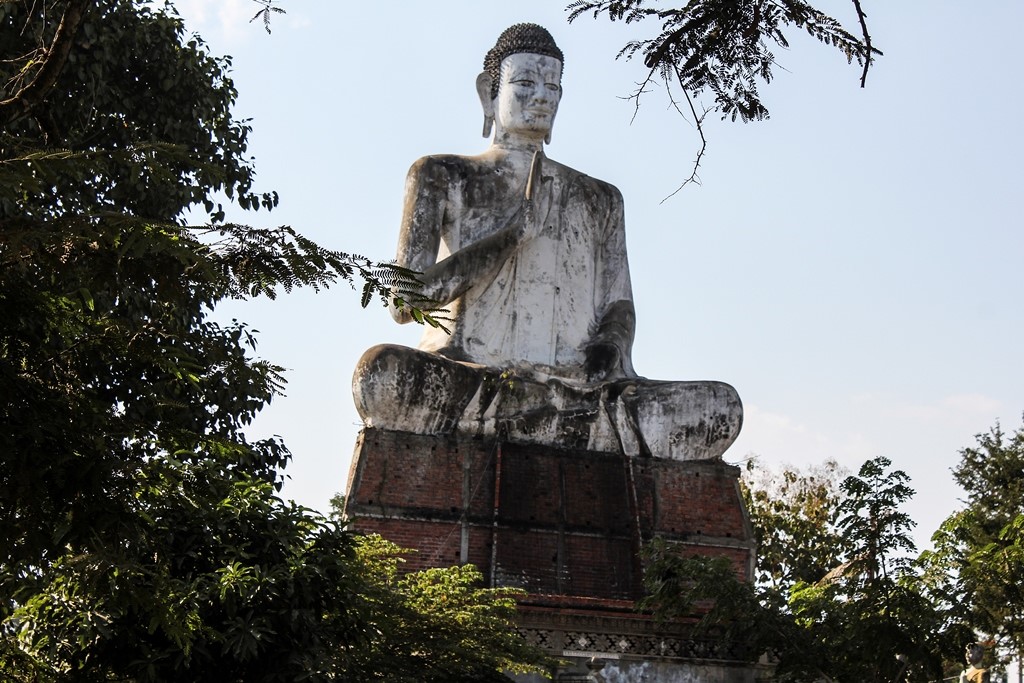
The temple is also the center of holiday festivities for the people of the nearby village. They dress up in their Sunday best and have a celebration between the old and the new temples and climb all around the ruins with their families. In addition, this is a popular destination for Khmers as well as a pilgrimage place for women hoping to conceive.
Lunch before leaving Battambang Province for route to the capital of Cambodia.
Check in hotel.
Overnight in Phnom Penh.
- Phnom Penh/ Takeo: 83kms, 2hrs; Takeo/ Kep: 86kms, 2 hrs
Breakfast at hotel.
AM: Excursion to Takeo Province.
Takeo (literally "Crystal Grandfather") is located in the south of Cambodia to the west of Bassac River, Takeo borders the provinces of Kampot to the west, Kampong Speu to the northwest and Kandal to the north and east. Its southern boundary is the international border with Vietnam. The provincial capital, recently known as the provincial town Doun Kaev (formerly called Takeo), is a small city with a population of 39,186.
Takeo province is often referred to as the cradle of Cambodian civilization and has several important pre-Angkorian sites built between the 5th and the 8th century. The provincial capital, Takeo town is an easygoing place that possesses a fair amount of natural and manmade beauty. The natural beauty is in the Scenic River and lake area that faces a pleasant town parkway. The low-lying area seems to include much of the surrounding province area, which is probably why a kingdom that once had its heart here was referred to as Water Chenla. There seems to be water everywhere in the surrounding countryside during the rainy season.
On the way visit Ta Prohm temple.
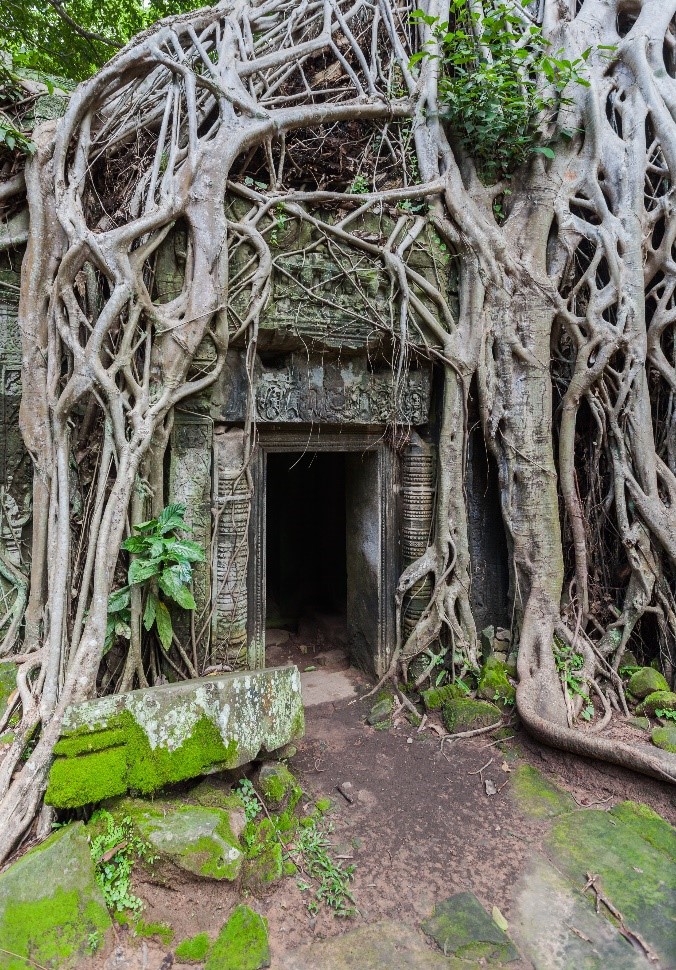
Ta Prohm is built in the late 12th and early 13th centuries. Ta Prohm is in much the same condition in which it was found: the photogenic and atmospheric combination of trees growing out of the ruins and the jungle surroundings have made it one of Angkor's most popular temples with visitors. UNESCO inscribed Ta Prohm on the World Heritage List in 1992. Today, it is one of the most visited complexes in Cambodia’s Angkor region.
The trees growing out of the ruins are perhaps the most distinctive feature of Ta Prohm, and "have prompted more writers to descriptive excess than any other feature of Angkor.
The temple of Ta Prohm was used as a location in the film Tomb Raider. Although the film took visual liberties with other Angkorian temples, its scenes of Ta Prohm were quite faithful to the temple's actual appearance and made use of its eerie qualities.
Continue to Takeo. Upon arrival, depart by boat to Angkor Borei.
Angkor Borei is a town in Takeo province in the area of several ruins and archaeological digs. The area has been continuously inhabited for at least 2500 years and has yielded artifacts dating from the Neolithic period, the Funan period (4th/5th century AD) and Chenla (8th century AD) as well as the later Angkorian period (9th-15th century AD.) There are no significant temple ruins at Angkor Borei but there is a very interesting little museum displaying artifacts from the area and providing information on recent archaeological digs.

Visit Phnom Da temple.
About 20km from Angkor Borei is the hill of Phnom Da, crowned by an impressive 11th century Angkorian-era brick and sandstone prasat (tower) displaying some carvings in good condition. This structure was probably an upgrade of an previously existing 7th or 8th century structure. The temple was constructed under King Rudravarman and dedicated to Shiva.Around the foot of the mount of Phnom Da, some five caves have been located. Sculptures related to Vishnu were found in those caves, some of which are currently housed in the National Museum of Cambodia in Phnom Penh.
Return to Takeo by speed boat.
Lunch before continuing to Kep, a beautiful coastal area.
Kep City, formerly known as Kep-sur-Mer. is a municipality in Cambodia with the status of a province. Kep is just a few kilometres from the border with Vietnam located and used to be Cambodia's most popular beach town but has fallen on hard times in recent years (especially due to the Khmer Rouge). Many of Kep's, mostly French villas are abandoned, but some of the town's former splendor is still apparent.
The see is lined with huge sidewalks and some large statues that now seem largely out of place. The king built a palace overlooking the Gulf of Thailand, but it was never furnished and now sits empty. A good, paved road connects the small town with Kampot. The beaches are not attractive as they are mostly scattered with mangroves and black rocks, but Koh Thonsay (Rabbit Island) is just half an hour boat ride.
Overnight in Kep.
- Boat transfer #30mn
Breakfast at your hotel.
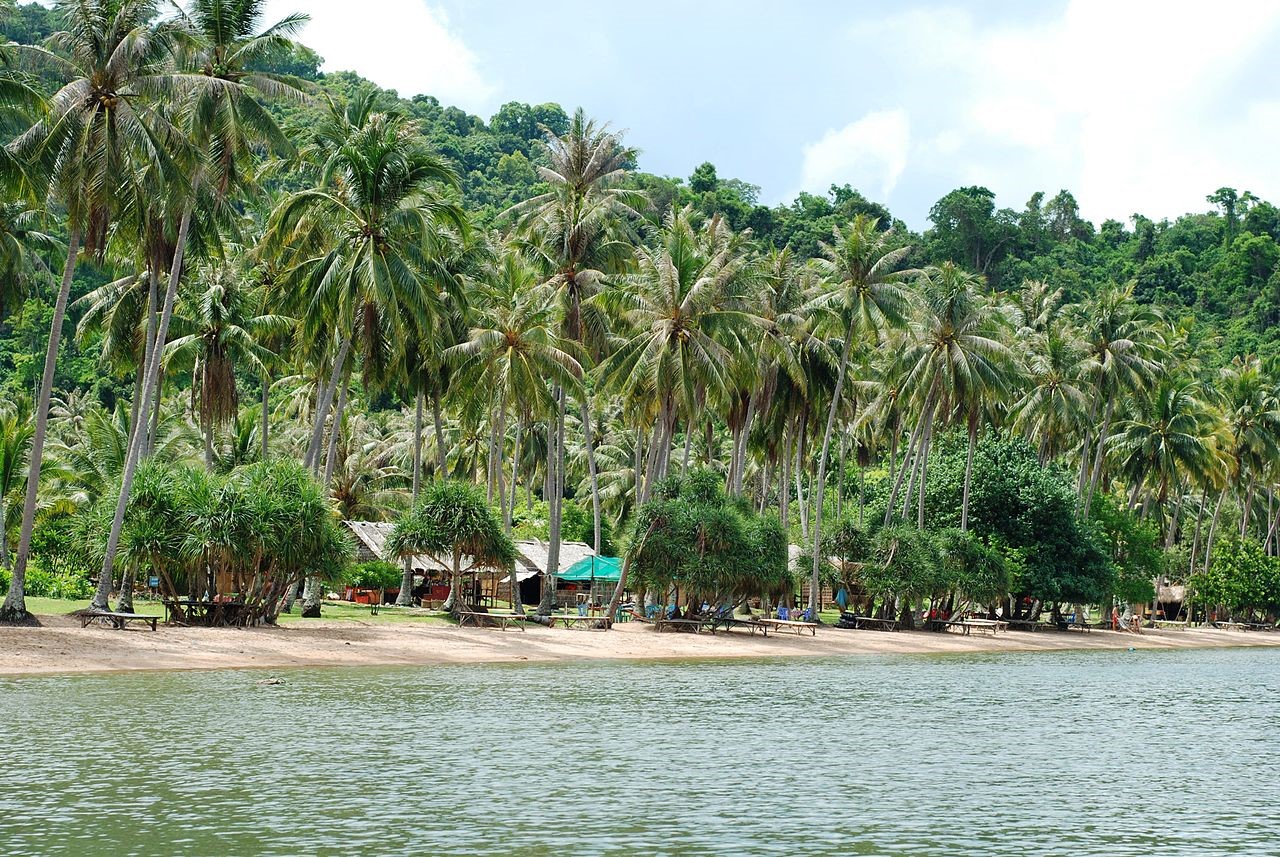
Full day boat trip to Rabbit Island where you can enjoy sea activities (snorkeling, scuba diving, beaches…) as well as sea food.
Overnight at Rabbit Island.
- Kep/ Sihanoukville: 120kms, 2hrs30mn
After breakfast, return to Kep by boat, then road transfer to Sihanoukville, via Kampot.
Kampot is a third largest coastal province located in the Southwest of Cambodia and best well-known for Kampot pepper, one of the finest pepper in the world. Its capital is Kampot town and sits near the base of the abundant green Elephant Mountains and the famous Bokor Hill Station.
Visit a pepper plantation.
Kampot is renowned for its excellent pepper which has more than a century long history and is one of the highest quality peppers in the world. The fresh climate and soil type of Kampot as well as the experience from several generations of pepper farmers make this pepper unique and much sought-after by gourmets worldwide. The specificities of the Kampot pepper come from the mildness of their spice, the freshness and complexity of their aromas and their exceptional lingering taste. Despite pepper cultivation being adversely affected by events in Cambodia’s recent history, small farmers in the region are using their traditional skills and knowledge to once again make Kampot pepper a valuable product.
Continue to Sihanoukville.
Arrival at check in hotel at Sihanoukville.
Overnight in Sihanoukville.
Breakfast at hotel.
Transfer to the port of Sihanoukville and embark on speedboat to SONG SAA ISLAND after 45 minutes speedboat.
Welcome drink & check-in.

In the warm emerald waters of the Gulf of Thailand, Cambodia’s islands nestle like dazzling natural jewels. Song Saa Private Island lies secluded in this magnificent seascape. Most of the islands remain undeveloped – deserted oases of virgin rainforests, tropical reefs and glistening white beaches. In Cambodia’s untouched Koh Rong Archipelago, two pristine islands lie side by side. They are known locally as Song Saa – Khmer for “The Sweethearts”. The resort spans the islands of Koh Ouen and Koh Bong, connected by a footbridge over Cambodia's first Marine Reserve we have established to safeguard the islands’ reefs and marine life including turtles, seahorses and exotic species of tropical fish.
Overnight at Song Saa Island.
- Boat back to Sihanoukville, then road transfer back to Phnom Penh 220km, approx. 4 hours
Morning free at your own leisure.
Afternoon road transfer back to Phnom Penh. Check in upon arrival.
Overnight in Phnom Penh
Free until transfer to airport for departure flight.
